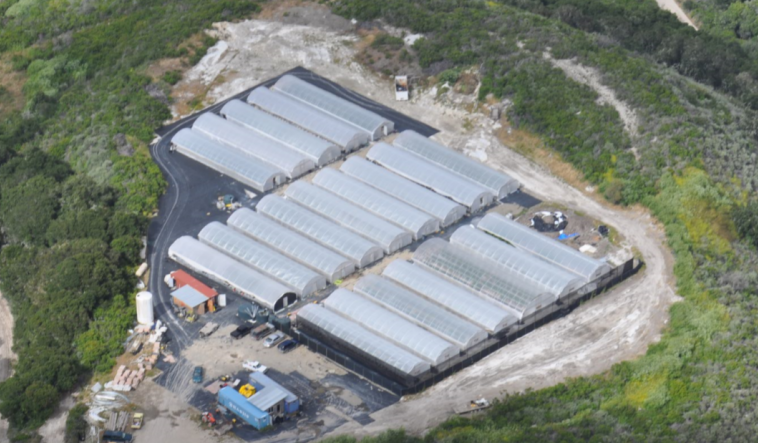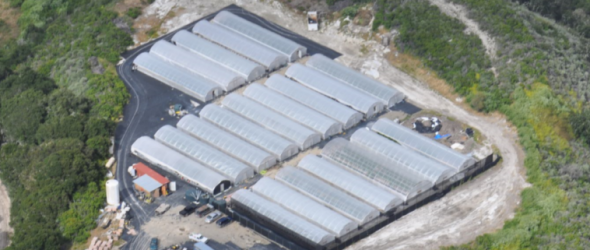July 6, 2020

By KAREN VELIE
In a scathing report on Santa Barbara County’s cannabis regulations, the Santa Barbara County Grand Jury lambasts county officials for behaving unethically, and creating rules that cost the county financially and compromise quality of life.
“Santa Barbara County has been in turmoil since the legalization of recreational cannabis in 2016,” according to the 26-page report released last week. “There has been public protest over cannabis odor, controversy between the cannabis industry and traditional agriculture, the appearance of financial irregularities and accusations of undue influence.”
The Santa Barbara County Board of Supervisors created an ad hoc committee comprised of supervisors Das Williams and Steve Lavagnino in 2017, to review the industry and create regulations for marijuana cultivation. Meetings of the committee were not subject to the Brown Act or opened to the public, two of the jury’s concerns.
“A more sobering realization for the jury was that the governance in this matter took the form of some supervisors aggressively pushing through their own agendas while other supervisors meekly followed or resigned themselves to the inevitable,” according to the report.
The Grand Jury also blasted the board over cozy relationships between two county supervisors and marijuana industry lobbyists. These relationships appear to have favored marijuana cultivators over residents.
“While the jury understands that sending emails to advocate positions favorable to the interests of their client is part of the job of a lobbyist, it was unnerving to the jury to see both the tone and timing of these emails,” according to the report.
One of the most egregious allegations is over a supervisor asking a lobbyist for advice on an issue as he sat on the dais. During a March 20, 2018 Board of Supervisors meeting, a board member sent an email to a cannabis lobbyist asking if they agreed with county planning department staff’s recommendation. The Grand Jury report does not name the supervisor.
The jury also noted concerns over county employees leaving their government jobs to work as cannabis consultants and lobbyists.
“This effort was amplified by some of the cannabis industry lobbyists having recently left the employment of Santa Barbara County,” according to the report. “It was described to the Jury that some of these cannabis industry lobbyists could be regularly seen roaming the halls of the board’s offices.”
As part of the early approval process, marijuana cultivators were required to provide an affidavit stating they had been growing on or before Jan. 19, 2016. But the county required no proof, and offered no oversight.
“The major and obvious flaw of this affidavit system was the lack of any required verification as to the veracity of whether the applicant had indeed been growing cannabis as of Jan. 19, 2016,” according to the report. “This concern was noted by the planning commission that recommended a process that included a public hearing wherein the applicant could prove their affidavit was truthful.”
The grand jury was also concerned with the large amount of cannabis cultivated in the county. While the yearly statewide consumption of marijuana is estimated to be between 1.6 and 2.5 million pounds, last year California cannabis cultivators produced approximately 13.5 million pounds. It is illegal to sell marijuana grown in California out of state.
“Santa Barbara is just one of 58 counties in California, but with almost 500 registrants seeking as many as 1,365 separate cultivation permits, the county’s growers could potentially produce over 3.7 million pounds of cannabis per year, which is more than double the legal amount of cannabis consumed by the entire state,” according to the report.
When cultivators smuggle portions of their crops to states where it remains illegal, tax revenue is rarely collected.
Both Williams and Lavagnino’s focus appeared to be on a robust cannabis industry and the tax revenue it could bring the county.
“I’m trying to generate what could be $20 [million] to $40 million a year for the county,” Lavagnino said at a board meeting in Feb. 2019.
But Williams and Lavagnino pushed through a tax system that appears to help growers avoid paying taxes on crops sold on the black market. Most California counties collect cannabis tax based on the square footage of cultivation, while Santa Barbara County collects taxes based on gross receipts.
Initially, Santa Barbara County predicted cannabis tax revenues as high as $25 million. However, in the 2018/2019 fiscal year, with 217 acres of permitted marijuana cultivation, Santa Barbara County collected only $6.8 million.
In comparison, with only 62 acres of permitted cannabis cultivation, Monterey County received cannabis tax revenues of $15.4 million for the 2018/2019 fiscal year.
“The answer the jury received was that the gross receipts method had the potential to be much more lucrative than the square footage method,” according to the report. “To date, the belief that using the gross receipts method would result in more taxes has not proven to be true.”
The Santa Barbara County Board of Supervisors has 90 days to respond to the Grand Jury report with either an agreement to implement the recommendations, reasons why the county will not implement the recommendations, or with a request for more time to analyze the report.
The Santa Barbara County Grand Jury’s findings and recommendations:
Finding 1: The impact of cannabis production on the health and welfare of Santa Barbara County residents was inadequately weighed and considered by the Santa Barbara County Board of Supervisors.
Recommendations: That the Santa Barbara County Board of Supervisors direct the county Planning and Development Department director to prepare environmental impact reports addressing each region of county after holding public hearings to evaluate public concerns.
That the Santa Barbara County Board of Supervisors direct the county Planning and Development Department director to develop project objectives for the environmental impact reports that reflect a balance between cannabis, traditional agriculture, and county residents.
Finding 2: The creation of a non-Brown Act Ad Hoc Sub Committee that was not open to the public led to a lack of transparency and distrust by county residents.
Recommendation: That the Santa Barbara County Board of Supervisors require all future Ad Hoc Sub Committees be open to the public and subject to the Brown Act.
Finding 3: The Board of Supervisors granted nearly unfettered access to cannabis growers and industry lobbyists that was undisclosed to the public during the creation of the cannabis ordinances.
Recommendation: That the Santa Barbara County Board of Supervisors develop standards that require board members to publicly disclose all access granted to lobbying individuals or groups, especially while a matter involving these individuals or groups is before the Board of Supervisors.
Finding 4: The conflict between cannabis production and traditional agriculture is a major concern for the continued existence of certain segments of traditional agriculture in Santa Barbara County.
Recommendations: That the Santa Barbara County Board of Supervisors amend the Land Use and Development Code and Article II, the Coastal Zoning Ordinance to require all pending cannabis land use permit applications be subject to a conditional use permit review.
That the Santa Barbara County Board of Supervisors amend the County’s Uniform Rules for Agricultural Preserves and Farmland Security Zones to declare that cannabis cultivation and related facilities are compatible uses on contracted land instead of as an agricultural use.
Finding 5: The amount of cannabis production allowed under the current cannabis ordinances is excessive and has led to over-concentration in some portions of Santa Barbara County.
Recommendations: That the Santa Barbara County Board of Supervisors require all applicants with cannabis use and development permit applications and licenses pending, who claim legal non conforming status, to prove their claimed status before the Santa Barbara County Planning Commission.
That the Santa Barbara County Board of Supervisors direct the county Planning and Development Department director, in conjunction with the sheriff’s office, to eradicate all cannabis grown on acreage claimed under legal non-conforming status when the cannabis operator fails to demonstrate to the Santa Barbara County Planning Commission that the planting of cannabis occurred prior to Jan. 19, 2016.
That the Santa Barbara County Board of Supervisors direct the county Planning and Development Department director to deny permits for the growth of cannabis on acreage claimed under legal non-conforming status when the cannabis operator fails to demonstrate to the Santa Barbara County Planning Commission that the planting of cannabis occurred prior to Jan. 19, 2016.
Finding 6: The approval by the Santa Barbara County Board of Supervisors of an unverified affidavit system does not require proof of prior cannabis operations to establish eligibility to continue to grow cannabis as a legal non-conforming use.
Recommendation: That the Santa Barbara County Board of Supervisors require all applicants with cannabis use and development permit applications and licenses pending, who claim legal non conforming status, to prove their claimed status before the county Planning Commission.
Finding 7: The affidavit system does not require proof of prior scope of the cannabis acreage.
Recommendations: That the Santa Barbara County Board of Supervisors direct the county Planning and Development Department director, in conjunction with the sheriff’s office, to eradicate all cannabis grown on acreage claimed under legal non-conforming status when the cannabis operator fails to demonstrate to the county Planning Commission that the planting of cannabis occurred prior to Jan. 19, 2016.
That the Santa Barbara County Board of Supervisors direct the county Planning and Development Department director to deny permits for the growth of cannabis on acreage claimed under legal non-conforming status when the cannabis operator fails to demonstrate to the county Planning Commission that the planting of cannabis occurred prior to Jan. 19, 2016.
Finding 8: The option taken by the Santa Barbara County Board of Supervisors to tax cannabis cultivation using a gross receipts method was less reliable than the square footage method used by the vast majority of California counties.
Recommendation: That the Santa Barbara County Board of Supervisors amend Ordinance 5026 to tax cannabis cultivation using the square footage method.
Finding 9: The Santa Barbara County Treasurer-Tax Collector was not included in the creation of the tax portions of the cannabis ordinance.
Recommendation: That the Santa Barbara County Board of Supervisors require that all future ordinances that involve taxation require the county Treasurer-Tax Collector be involved in the creation of the ordinance.
Finding 10: Members of the Santa Barbara County Chief Executive Officer’s office and county staff, unduly and without apparent board knowledge, successfully sought changes to the April 26, 2019 Cannabis Advisory from the Santa Barbara County Air Pollution Control District, an independent agency, eliminating a one mile buffer recommendation.
Finding 11: There has not been effective odor control at the boundary of cannabis cultivation and related activities, resulting in significant public outcry about odor, quality of life and health concerns.
Recommendation: That the Santa Barbara County Board of Supervisors suspend all county unpermitted cannabis operations until proof of odor control at the boundary of their operation is accepted by the county Planning Commission.
Finding 12: The Santa Barbara County Board of Supervisors does not have a written code of ethics to formalize its ethical standards and guide its decision-making processes.
Recommendations: That the Santa Barbara County Board of Supervisors establish, staff and empower an independent ethics commission with oversight over the board and its staff members.
That the independent ethics commission develop a code of ethics, review board activities on a periodic and as-needed basis for compliance, and share its findings with the public.
That the Santa Barbara County Board of Supervisors require all its members to publicly disclose receipt of campaign contributions from donors who have matters pending a decision by the board.
That the Santa Barbara County Board of Supervisors require those members receiving campaign contributions from donors with matters pending a decision, to recuse themselves from those matters or return the campaign contributions.


